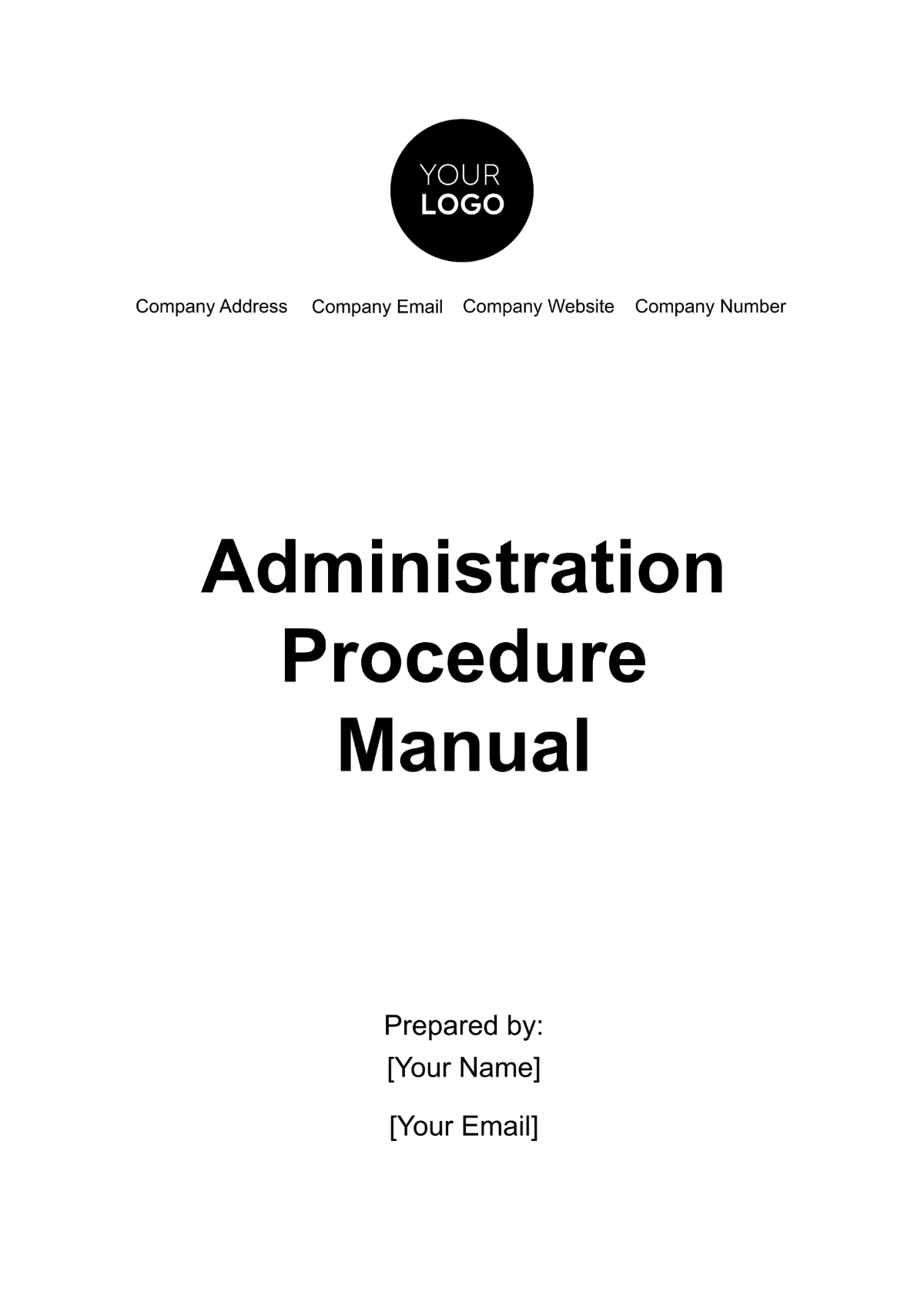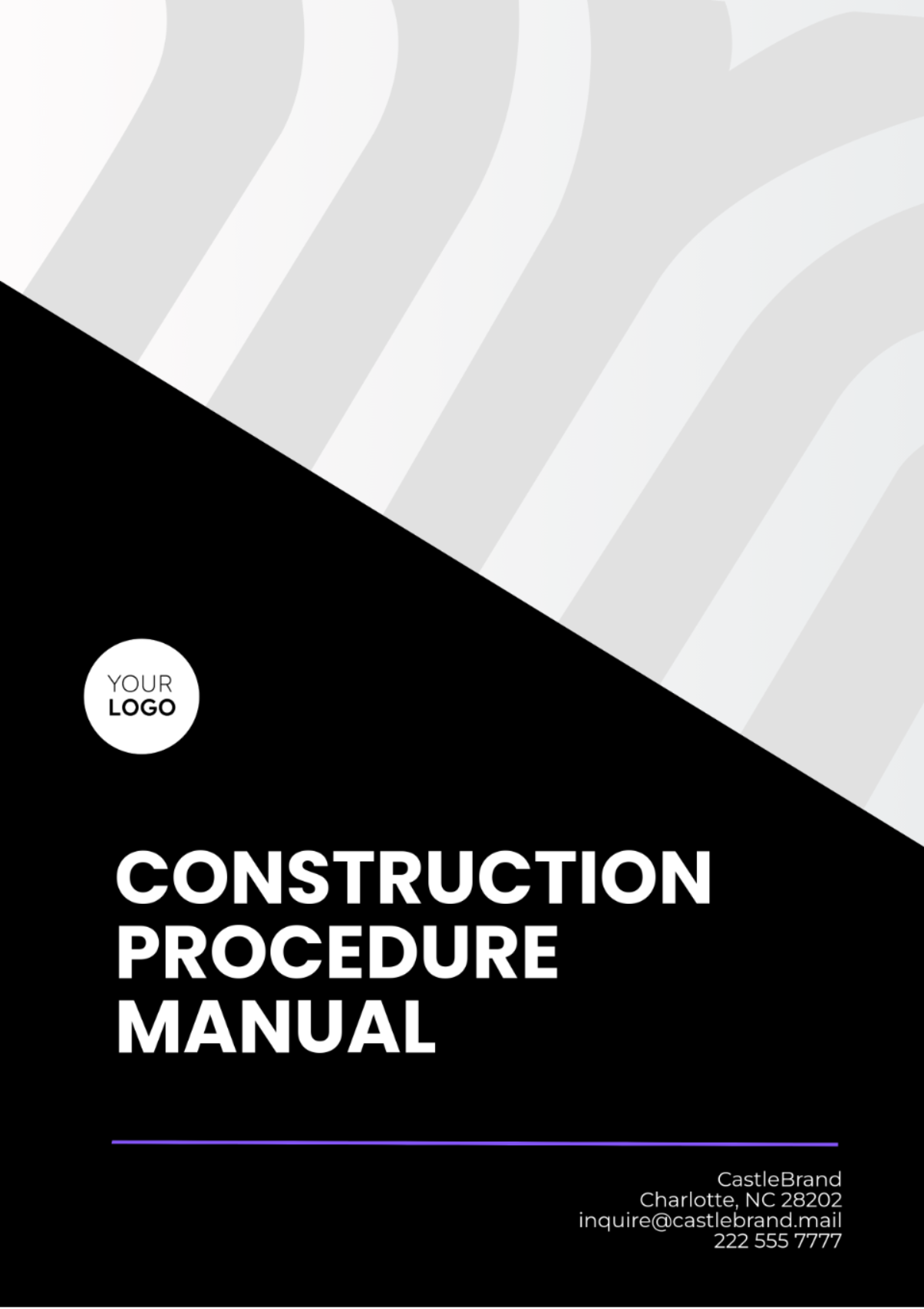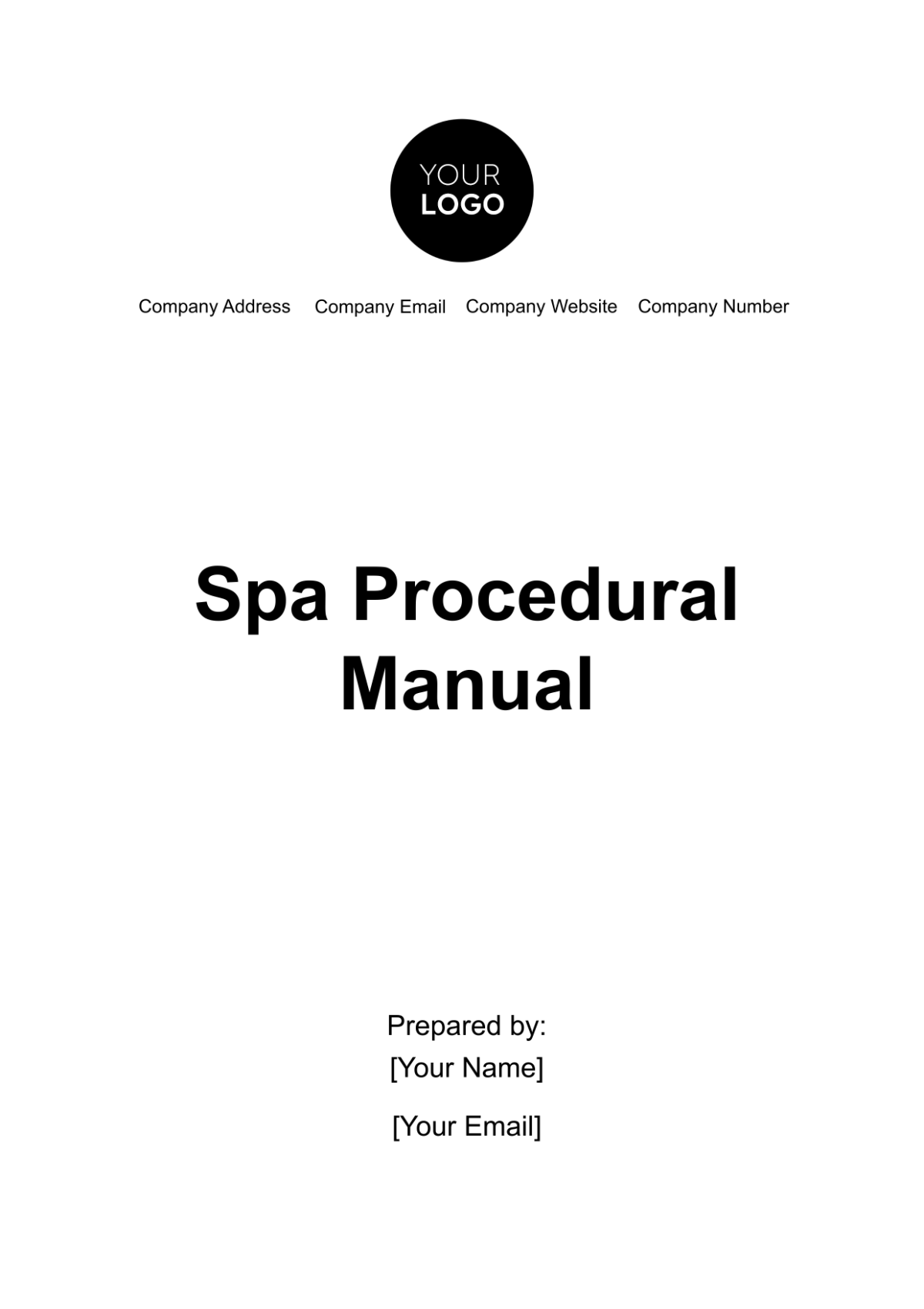Finance Budget Policy & Procedure Manual
Published by [Your Company Name] - [Year]
For inquiries: [Your Company Email] or at [Your Company Number]
Introduction
This document serves as a guiding framework and operational manual for our financial budgeting processes. In the dynamic world of business, the need for a structured and strategic approach to financial management is paramount. As [Your Company Name] continues to grow and navigate the complexities of the market, it becomes increasingly important to have a robust system in place for managing our financial resources. This manual is not just a set of instructions; it is a reflection of our commitment to financial discipline, strategic planning, and overall organizational excellence.
Purpose
The primary objective of this manual is to delineate clear and comprehensive policies and procedures for financial budgeting within [Your Company Name]. It aims to serve several key purposes:
Strategic Alignment: To ensure that all budgeting activities are in line with the strategic goals and objectives of our organization, facilitating a coherent path towards growth and sustainability.
Resource Optimization: To promote the most efficient and effective use of financial resources, ensuring that every dollar spent contributes to the value and progress of the company.
Financial Control and Governance: To establish a framework for financial control, ensuring compliance with both internal standards and external regulatory requirements, thereby safeguarding the company’s assets and interests.
Transparency and Accountability: To foster a culture of transparency and accountability in financial matters, empowering informed decision-making at all levels of the organization.
Continuous Improvement: To provide a basis for continuous improvement in financial management practices, adapting to changes in the business environment and leveraging new opportunities for growth.
Scope
This manual is comprehensive in scope, encompassing all aspects of the budgeting process at [Your Company Name]. It is applicable to:
All Departments: Every department within the organization, irrespective of its size or function, is expected to adhere to the policies and procedures outlined in this manual during the budgeting process.
All Employees: This includes employees at all levels who are involved in budget preparation, approval, and management, ensuring a cohesive and unified approach across the organization.
Diverse Financial Activities: The manual covers various aspects of budgeting, including preparation, review, approval, monitoring, and reporting, providing a complete toolkit for effective financial management.
Change Management: As the company evolves, the policies and procedures within this manual will be subject to review and updates, ensuring their relevance and effectiveness in a changing business landscape.
By adhering to the guidelines in this manual, [Your Company Name] aims to achieve a high standard of financial efficiency and integrity, contributing to our overall mission and vision.
Budget Policy
Policy Statement
At [Your Company Name], we are dedicated to upholding a comprehensive and effective budgeting process that is intricately aligned with our strategic objectives. Our commitment is rooted in the belief that a well-structured budget is pivotal to the financial stability and long-term success of our organization. This policy statement serves as the cornerstone of our approach to financial planning, emphasizing the need for a budget that not only supports our current operations but also lays the foundation for future growth and resilience. By integrating principles of transparency and accountability, we aim to foster trust among our stakeholders and ensure that our financial practices reflect our organizational values and ethics.
Principles
1. Alignment with Strategic Goals:
Objective: Ensure that every aspect of the budget is crafted to support the strategic objectives and priorities of [Your Company Name].
Implementation: This involves a collaborative process where budget allocations are directly linked to strategic plans, initiatives, and expected outcomes.
2. Cost-effectiveness:
Objective: Achieve the optimal use of financial resources, maximizing value while minimizing unnecessary expenditures.
Implementation: Regular cost-benefit analyses, seeking efficiencies, and promoting a culture of cost consciousness across all departments.
3. Compliance with Regulatory Standards:
Objective: Adhere to all applicable laws, regulations, and industry standards, ensuring legal and ethical financial practices.
Implementation: Regular updates and training on regulatory changes, rigorous compliance checks, and internal audits.
4. Transparency and Accountability:
Objective: Maintain openness and clarity in all budgeting processes, ensuring that stakeholders can easily understand and evaluate our financial practices.
Implementation: Clear documentation of budget decisions, open channels of communication, and regular financial reporting to stakeholders.
These principles are integral to our approach to budgeting and are expected to be embraced by all employees involved in the budgeting process. They are not just guidelines but a reflection of our commitment to responsible, ethical, and effective financial management. Through adherence to these principles, [Your Company Name] aims to sustain a financial strategy that is robust, forward-thinking, and aligned with our vision for the future.
Budget Procedure
The budget procedure at [Your Company Name] is a structured and systematic process designed to ensure the creation, monitoring, and management of an effective budget that aligns with our strategic goals. This chapter outlines the detailed procedures for budget preparation and monitoring, ensuring a clear understanding of responsibilities and timelines for all involved parties.
Budget Preparation
Timeline and Responsibilities:
Activity | Responsible Party | Deadline |
|---|---|---|
Initial Budget Draft | Department Heads | [Month Day] |
Review and Feedback | Finance Department | [Month Day] |
Final Draft Submission | Department Heads | [Month Day] |
Executive Review | CEO/CFO | [Month Day] |
Procedure:
1. Initial Budget Draft:
Each department head is responsible for preparing an initial draft of their department's budget. This draft should include projected revenues and expenditures, aligned with the department's goals and the overall strategic objectives of [Your Company Name].
The draft should be comprehensive, realistic, and based on accurate and current financial data.
2. Review and Feedback:
The Finance Department reviews each department's initial budget draft. This review is aimed at ensuring consistency with company-wide financial goals, accuracy of projections, and adherence to financial policies.
Feedback and recommendations are provided to each department for refinement and adjustments.
3. Final Draft Submission:
Following the feedback from the Finance Department, department heads adjust and finalize their budgets. This final draft should reflect any required changes and incorporate feedback received.
The final draft is then submitted to the Finance Department for consolidation.
4. Executive Review:
The CEO and CFO conduct a final review of the consolidated budget. This step ensures strategic alignment and financial feasibility at the highest level.
Upon approval, the budget is officially adopted for the upcoming fiscal period.
Budget Monitoring
Monthly Review:
Each month, actual expenditures and revenues are compared against the budgeted figures.
The Finance Department, in collaboration with department heads, documents any variances and investigates the reasons behind these discrepancies.
Based on the insights from this comparison, plans may be adjusted to ensure the continued financial health and strategic alignment of [Your Company Name].
Regular reporting and communication of budget performance to the executive team and other stakeholders are essential for transparency and informed decision-making.
This comprehensive approach to budget preparation and monitoring is crucial in maintaining the financial integrity and operational effectiveness of [Your Company Name]. It is a collaborative effort that requires diligence, accuracy, and strategic foresight from all departments and individuals involved in the process.
Roles and Responsibilities
The successful execution of the budgeting process at [Your Company Name] is contingent upon the clear definition and understanding of the roles and responsibilities of key personnel involved in the process. This section delineates the specific duties and expectations associated with each critical role in the budgeting cycle. From the overarching strategic decisions made by our CEO and CFO to the detailed management and coordination by the Finance Department and the hands-on involvement of Department Heads, each role plays a vital part in ensuring the financial health and strategic alignment of our organization's budget. The delineation of these roles not only promotes efficiency and clarity in the budgeting process but also fosters a sense of accountability and ownership among all participants. Understanding and fulfilling these roles is crucial for the smooth operation of our budgeting system and the achievement of our financial and organizational goals.
Role | Responsibilities |
|---|---|
CEO/CFO | Overall budget approval and strategic alignment |
Finance Department | Budget coordination, review, and reporting |
Department Heads | Drafting and managing departmental budgets |
Budget Review and Approval Process
The Budget Review and Approval Process at [Your Company Name] is a critical phase in our financial management cycle. This process ensures that our budget is not only carefully crafted but also rigorously evaluated and approved by the appropriate authorities within the company.
Steps:
Initial Review
By: Finance Department
Conducts a thorough review of the consolidated budget, analyzing its alignment with strategic goals, adherence to financial policies, and accuracy. Assesses the budget's contribution to fiscal responsibility and sustainability.
Executive Approval
By: CEO/CFO
Reviews the budget post-Finance Department analysis for final approval. Focuses on strategic alignment and feasibility in relation to the company's long-term goals and market dynamics. May request changes or provide additional instructions.
Communication
By: Finance Department
Communicates the approved budget to all departments, ensuring transparency and understanding of financial allocations and responsibilities. Provides guidance or training for effective budget management.
This structured review and approval process is fundamental to maintaining the integrity of our financial operations. It not only ensures that our budget is thoroughly vetted and aligned with our strategic objectives but also fosters a culture of collaboration and accountability across all levels of the organization.
Amendments and Revisions
Our business environment is dynamic, and circumstances can change, necessitating adjustments to our budget. To accommodate these changes while maintaining financial discipline and transparency, we have established a structured process for handling amendments and revisions to our budget.
Amendments
Process: Any amendments to the budget, whether they involve reallocating funds, addressing unforeseen expenses, or adjusting revenue projections, must undergo the same rigorous approval process as the initial budget. This ensures consistency in our financial management practices.
Approval: Amendments require approval from the same levels of authority as the original budget. This typically involves a review by the Finance Department, followed by executive approval from the CEO and CFO.
Rationale: The need for an amendment should be clearly justified and documented, outlining the reasons for the change and its expected impact on the overall financial health and strategic goals of the company.
Revisions
Documentation: All revisions, minor or major, need to be meticulously documented. This documentation should include details of the original budget figures, the nature of the revisions, and the revised figures.
Communication: It is critical that revisions are communicated effectively to all relevant parties. This includes department heads, the finance team, and, where necessary, the executive team. Transparent communication ensures that all stakeholders are aware of the changes and can adjust their plans and expectations accordingly.
Review: Depending on the nature and extent of the revisions, a formal review may be necessary to assess their impact on the company’s financial projections and strategic objectives.
This process for amendments and revisions is designed to ensure that [Your Company Name] remains agile and responsive to changes while upholding the principles of financial integrity and strategic alignment. By adhering to these guidelines, we can adapt to evolving business needs and opportunities without compromising on our commitment to sound financial management.
Appendices
Appendix A: Budget Form Template
Appendix B: Budget Variance Report Template
Appendix C: Contact Information

















































